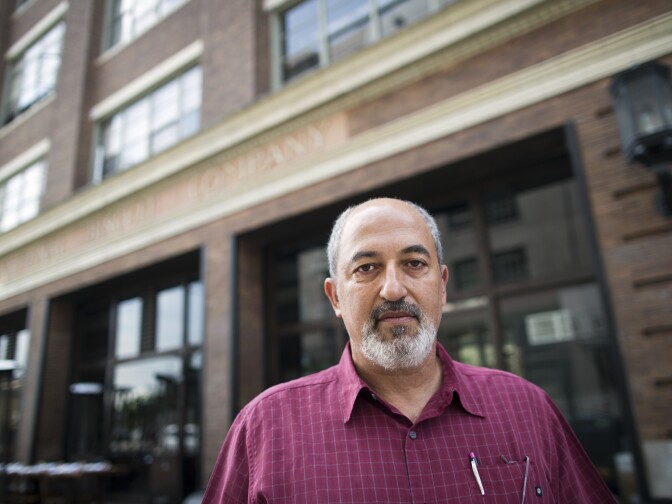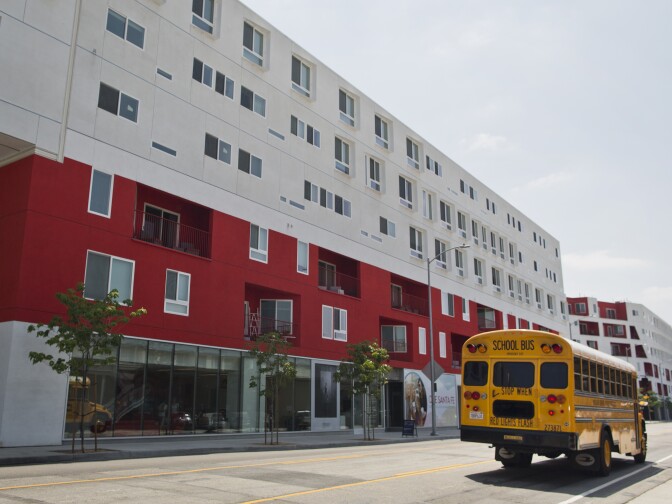With our free press under threat and federal funding for public media gone, your support matters more than ever. Help keep the LAist newsroom strong, become a monthly member or increase your support today.
Keeping artists in LA's Arts District
Entering Jett Jackson’s 275 sq. foot loft in L.A.’s Arts District is like stepping onto a submarine.
To the right is the bathroom she shares with her neighbor. Past the kitchen or 'galley' is her bed, just inches from her easel and canvas. A painter, Jackson would like more space, but this subsidized unit is all she can afford since her neighborhood has become one of L.A.’s trendiest.
This industrial pocket in downtown L.A. is where artists like Jackson first came in the late 1970s to find cheap studios in former warehouses and factories. But over time, the art scene glamorized the area, and in an urban renewal storyline played out in cities all around the world, shops, restaurants and developers soon followed.
“People who come to this neighborhood don’t even know an artist,” Jackson, 57, said. “We aren’t the main driving force behind the neighborhood anymore.”
Jackson wants the artists back, and she thinks the city may have a way to do it. The planning department is pushing a proposal that would require residential developers to build live/work units in industrial areas like the Arts District instead of conventional apartments. As Senior City Planner Patricia Diefenderfer recently told the Planning Commission, “this ordinance is responding to the changing nature of work, and people’s desire to work and live in the same place.”
A place with an open floor plan, higher ceilings – great for programmers, designers and of course artists. Developers, under the plan, would be allowed to build more units if they did specific things like set aside housing for low income tenants. The promise of affordable housing had painter Sylvia Tidwell testifying in support for the new regulations, which need City Council approval.
“The Arts District is a ghost town,” Tidwell said. “The artists have a saying, last artist out, turn off the light.”
But others are critical of the planning department’s proposal. They question whether it will help artists stay in the neighborhood and whether they’d even want to stay. Adrian Scott Fine of the Los Angeles Conservancy said the city plan does not go far enough to protect the unique physical character of the Arts District — what drew artists there in the first place.
“If we don’t protect that, what are we protecting?” Fine said. “We’ll have an Arts District that doesn’t look and feel like an Arts District that everybody has come to discover and love.”
A painting by Jett Jackson depicting changes to the Arts District and the loss of artists. (Photo: Courtesy of Armando Duran Cepeda and Jett Jackson)
Residents fighting the city plan in its current version are upset with its evolution. The proposal was a direct response to development pressures in the Arts District. But in the time it was first announced more than a year ago, the city has decided to apply the guidelines to other industrial areas across the city. That’s angered many residents, who say they are not opposed to development but think a one-size-fits-all approach sells their neighborhood short.
“We can do so much better,” said Yuval Bar-Zemer, an Arts District resident and developer. “The train is not going in the right direction.”
Bar-Zemer said the city has ignored many of the community’s requests including that artists get preference for affordable housing, and that provisions be put in to retain the area’s artistic vibe.
To his dismay, the current version of the plan allows for builders to use wood construction, cheaper than the sturdier steel and concrete that gives the district its unique look.
And he said the minimum required size for live/work units — 750 square feet — is too small. He thinks people would end up using them strictly as residences then leave when they want more space. He said that’s already happening with newer developments in the district such as One Santa Fe.
“It’s more like temporary housing for people between 25 and 35,” Bar-Zemer said. “To me this is not how you build a community.”
Preservationists such as the LA Conservancy's Fine said the city plan also does not do enough to incentivize developers from tearing down old industrial buildings that give the district its gritty character.
"There's going to be more and more pressure on these buildings, and there's a knee-jerk reaction to start from new," Fine said.
A panorama of One Santa Fe, a new development that's garnered mixed reviews from neighbors. (Maya Sugarman/KPCC)
Many residents feel that the city’s proposal is being driven by the bottom lines of developers. But developers are not entirely happy with the plan either.
“In a perfect world, there should be more flexibility, and the requirements should be less onerous,” said Carol Schatz who promotes downtown development as the president of the Central City Association.
Schatz said developers, in exchange for the ability to build more units, are being asked to give up too much of their buildings to communal art space like studios and galleries. The ordinance as written requires builders to put aside 200 square feet for each live/work unit.
But she said developers still want the plan to go through because the city isn’t taking applications for new construction in the Arts District pending new regulations. Schatz said her members are eager to get to work on hundreds of units.
“The developers are very confident that we have built such a now vibrant 24/7 downtown - and the Arts District is clearly part of that - those units will be filled,” Schatz said.
Artist Jett Jackson said developers would be smart to keep artists around.
“If they really thought about what brought people to the neighborhood originally are the artists and the hip factor,” Jackson said. “So the minute you have less art, you’ve just got a lot of expensive places to live.”
Jackson said she knows the city’s plan is far from perfect but she wants to see something happen soon. Young artists graduate from school every year and need a place to live. Artists from all over the world come to make their way in LA’s art scene.
She’d like to see them land in the Arts District. Remember that saying, last artist out turn out the lights? She doesn’t want that to be her.

















